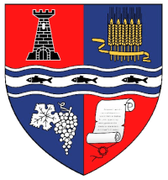Sâniob
| Sâniob Szentjobb | |
|---|---|
| Commune | |
| Country |
|
| County | Bihor County |
| Population (2011)[1] | 2,285 |
| Time zone | EET (UTC+2) |
| • Summer (DST) | EEST (UTC+3) |
Sâniob (Hungarian: Szentjobb, Turkish: Şenköy) is a commune in Bihor County, western Romania. The village was named after Stephen I of Hungary's Szent Jobb ( or "Holy Dexter") - his preserved right hand which was kept in an abbey here. The name was granted by Ladislaus I of Hungary in 1083. It was conquered by the Ottomans in 1661, becoming the seat of a sanjak in Varat Eyalet. Called "Şenköy" by the new authorities, it was captured by the Habsburg Monarchy in 1691.
It is composed of four villages:
- Cenaloş (Csanálos), to the southeast of Sâniob
- Ciuhoi (Berettyócsohaj; Hungarian pronunciation: [bɛrɛcːoːt͡ʃohɒj]), to the south of Sâniob
- Sâniob
- Sfârnaş (Berettyófarnos), to the southwest of Sâniob
At the 2011 census, 56.7% of inhabitants were Hungarians, 37.3% Romanians and 5.6% Roma. 46.1% were Roman Catholic, 29% Romanian Orthodox, 16.4% Reformed, 5.9% Pentecostal and 0.9% Greek-Catholic.
Known as Sâniob prior to 1968, the commune's name was changed to Ciuhoi that year and its seat moved to the latter village. In 2012, the commune's previous name was revived and the seat moved back to Sâniob village.
References
- ↑ Romanian census data, 2011; retrieved on March 1, 2013
Coordinates: 47°16′00″N 22°08′00″E / 47.2667°N 22.1333°E
